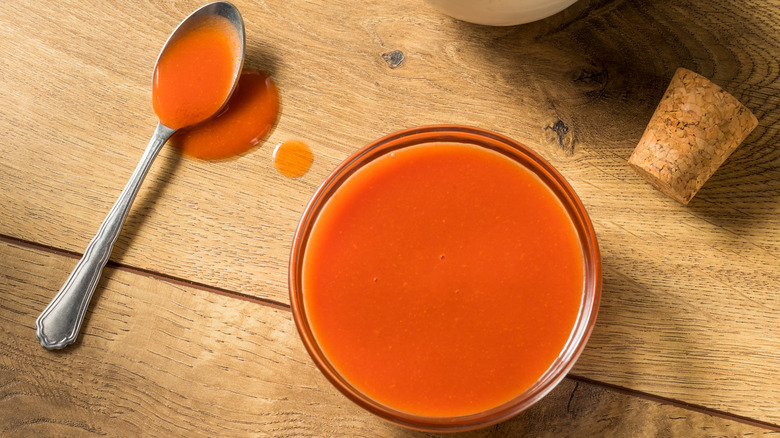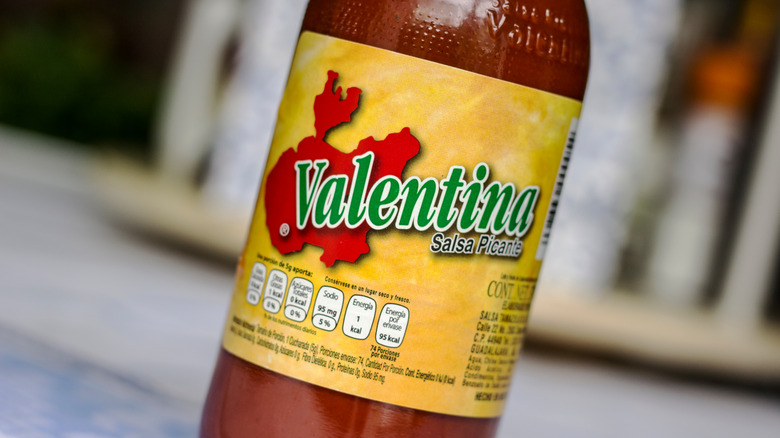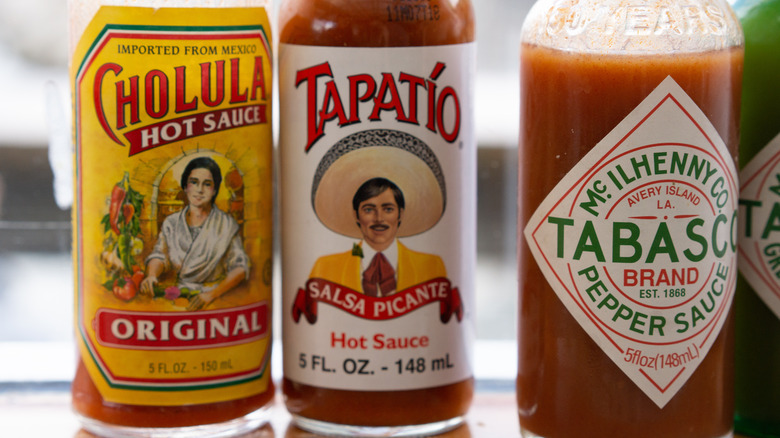What Makes Mexican-Style Hot Sauce Unique?
If you feel you've noticed an explosion of jalapeño-flavored cheese snacks or flaming hot everything taking over your local grocery store shelves lately, you're not imagining things. There is a new craze for all things spicy. In a statement, Frito-Lay told Eater, "Spicy salty snacks have spiked in popularity in recent years with the category growing 12% in the last four years." Similarly, it's not just spicy snacks having a moment in the States, but hot sauce is flying off the shelves, as well.
And the demand for hot sauce is not just rising in the U.S. but globally. According to a report by Facts & Factors, the demand for hot sauce is quickly growing, with projections of the "Global Hot Sauce Market size expanding from USD 2.75 Billion in 2020 to USD 4.91 Billion by 2026."
With all this new emphasis on spicy condiments internationally, it's helpful to know which hot sauces to start stocking your shelves with. From Thailand's famed Sriracha to New Mexico's beloved red and green hatch chilies, there's a lot to choose from when it comes to livening up your eggs in the morning or deciding what to squirt into your ramen noodle bowl.
However, possibly one of the most versatile and unique blends of chiles you can buy comes from Mexican-style hot sauces. If you're not familiar with this family of hot sauces, stick around, and you'll be an expert in no time.
What is Mexican-style hot sauce?
According to Serious Eats, Mexican-style hot sauce, also known as salsa picante, is a smooth variety of hot sauce that usually uses a blend of pepper types rather than utilizing just one variety. Typically, the combination is made up of habanero, chipotle, pequin, and jalapeno chilies, as Taste of Home notes. Arbol pepper is also used in Cholula's original hot sauce blend. Mexican-style hot sauce frequently has a thinner consistency than some other sauce brands, and they do not ferment their peppers.
The country's most popular hot sauce brands include Cholula, Valentina, and Tapatío. Cholula is likely the one you've seen at your favorite local Mexican food establishments with its iconic wooden caps. While these brands all have their unique blends and formulas, The Washington Post notes that these varieties usually have a very strong chile flavor with less tang than other types of hot sauce.
How does Mexican-style hot sauce differ from others?
The hot sauce that Mexican style is arguably most similar to is Louisiana style. According to Taste of Home, Tabasco and Frank's Red Hot are the most recognizable hot sauce brands in the Louisiana-style category. While they may taste similar, look the same, and both have a thinner consistency, there are a few notable differences between the Mexican-style and Louisiana-style hot sauces. The largest difference is the acidity levels. As Taste of Home notes, chilis, vinegar, and salt are the three main components of the traditional Louisiana version while salsa picante has just a little vinegar — likely, just enough to keep it shelf stable, as Serious Eats notes. So, if you're one-with-the-tang, you may want to keep Tabasco as your go-to, but if that dried chile flavor is your jam, stick with the picante.
Secondly, many well-known hot sauces, like Sriracha and Tabasco, are fermented. While most of these brands also use vinegar as a tool for preservation, they are often fermented for the flavor factor. Mexican-style sauces, on the other hand, do not utilize a fermentation process. And, since this time-consuming step is skipped when making fresh salsa picante, it's a much easier variety to make at home.
How Mexican-style hot sauce is made and eaten
There are plenty of reasons to make your own batch of hot sauce right at home. One perk, as The Spruce Eats points out, is that you can easily adjust the spiciness levels to match your preferences. And Mexican-style hot sauce is especially easy to make, even for beginners.
In Allrecipes' copy-cat Cholula recipe, the outlet starts off with the dried pequin and arbol pepper combination that Cholula is famous for. The first step is to simply combine all the peppers, spices, vinegar, and water together in a pan over medium heat and then blend until smooth. After cooling, the hot sauce base is mixed with water and xanthan gum for thickening.
While Mexican-style hot sauce is likely most commonly found on American tables when tacos or quesadillas are served, there are plenty of other delicious uses for it. Salsa picante can be included on just about anything, from grilled cheese sandwiches to pizza slices. Even meatloaf can benefit from this enjoyable flavor kick. And, one of our all-time favorite combinations is including Mexican-style hot sauce atop fresh breakfast food: Chicken and waffles with scrambled eggs are particular favorites.
Whatever you choose to dab — or pour — Mexican-style hot sauce over, we're sure it will change how you eat that food forever.



